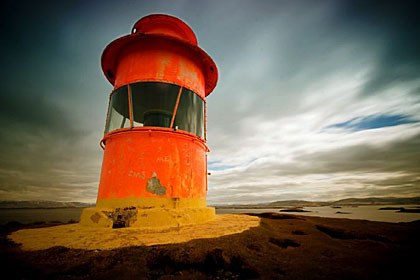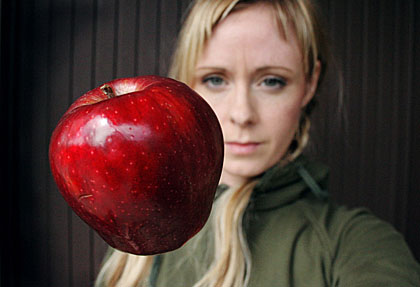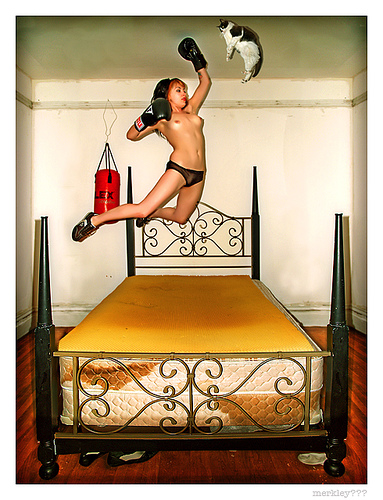
"Lighthouse," Rebekka Guoleifsdottir, All rights reserved
Virginia Heffernan's "Sepia No More" article in today's New York Times Magazine gets a few things right. She contends that a distinct visual style, "the Flickr photograph," has emerged from Flickr.com, the popular photo-sharing website. I'd say she's right.
"People don’t upload to the Web words and images they had fashioned apart from the Web; they fashion their stuff specifically for online platforms and audiences," Heffernan explains. Flickr photos are digital images that "... 'pop' with the signature tulip colors of Canon digital cameras." They are visual gestalts, designed to be eye-catching as tiny thumbnails and fully readable at Flickr's normal viewing size of 500 pixels. They favor strong, photoshop-enhanced colors, crisp focus and heavy contrast. They are not overly concerned with reality, instead mounting "... a case against vérité rawness, in favor of posing, cropping and special effects."
All true. But, I think it's also worth pointing out that, aside from the photoshop tweaks, pictures on Flickr are not actually very different in intention from classic Kodachrome & Kodacolor snapshots of the 60s and 70s. The subject matter is mostly staged, attractive people, romantic places, families, pets, memorable events. The look generally includes clear lighting, sharp focus & bright, saturated colors . Like the Kodak snaps, Flickr is mostly about creating a happy, pretty universe of the imagination -- OK, there are more tilted horizons.
Of course it should go without saying that many Flickr photographers are having none of this. Digital photography -- with the web as a key disseminator -- may well be forging a new aesthetic, but most shooters know the trend is much bigger & more complicated than what's getting "favorited" at the photo sharing sites . Sites like Flickr are not, as Heffernan seems to think, an arena for some decisive battle between analog vs. digital, art school vs. self-taught, museum vs. screen. In fact, even if established photo art stars (& those dutifully following the art school-endorsed route to such eminence) may in some cases feel threatened, the museums seem intrigued. Last year's "We are all photographers now" show at Musee de L'Elysee in Lausanne & the upcoming "Click" show at the Brooklyn Museum, for example, both ask: Who really deserves to be called an artist? Who decides?
Some have predicted that near-universal access to the web will usher in an electronic democracy of art, but I'm not convinced. In one form or another, I think talent, connections, ambition & luck will collide with the prevailing zeitgeist to create reputations, as they always have. But it's also clear that the worldwide web has opened a new door for these volatile elements, & that it won't be shutting soon.

"Self-portrait with apple," Rebekka Guoleifsdottir, All rights reserved
I've been on Flickr since 2004. Before that I was on Fotolog for a few years. I know what it's like to regard a photo sharing site as a self-contained universe, full of creative friends and intriguing imagery. I owe some good real world friends, a fair number of photo sales, even an important show to online photo networking. I use Flickr to connect with other's lives and catch up on gossip, as a handy archive for what I call my digital work prints and to edit my pictures into whatever package I'm working on. But I don't regard Flickr as a movement.
I wonder if Heffernan, whose column, after all, exists to tout the prowess of trippy online technology, does. The two Flickr photographers she uses to illustrate her thesis certainly don't have much in common . Rebekka Guoleifsdottir is an Icelandic artist who took up photography only recently. A woman of truly exceptional physical beauty, she began posting self-portraits, some of them nude, along with nature & landscape shots, family pictures & so on. The nudes -- handled with an earnest high classical modesty -- were naturally a huge hit, both because Guoleifsdottir is a stunning & exquisitely fit woman & because she quickly became a competent photographer.
But there's more to her meteoric rise to viewer-count heaven than the simple monkey magnetism of beautiful nudes. As Heffernan points out, Guoleifsdottir also learned to play the Flickr game. "She discovered how to create the minicollections called 'photostreams' [sic]; how to create images that would look good shrunk, in 'thumbnail' form; and how to flirt with the site’s visitors in the comments area to keep them coming back. As perhaps is always the case with artists, Guoleifsdottir’s evolution as a photographer was bound up in the evolution of her modus operandi, a way of navigating the institutions and social systems that might gain her a following and a living....(She) learned how to title and tag photos so that they might readily come up in searches; how to police copyright transgressions (as when some of her photos were sold illegally on eBay); and how to push contrasts by processing her pictures with Photoshop software."
Fine, but I thought we were talking about photo art. Guoleifsdottir’s nudes are technically excellent but quite traditional -- really nothing special as photographs (interestingly, I'm pretty sure she took a bunch of them down from her site; I visited it some time ago & seem to remember that there were dozens). Her later self-portraits, which use photoshop to replicate herself as her own twin, are more interesting, as are a number of other projects. But in the end Guoleifsdottir's output feels to me like that of a talented, hard-working artist still climbing a learning curve toward what she really wants to say. One of her Flickr sets is titled, "conceptual artsy type stuff". That tells you something.

"Lulu & Bubba," Merkley, All rights reserved
Heffernan's other choice to represent 'the Flickr photograph' is even more curious. A San Francisco photographer on Flickr who calls himself Merkley , he's a huge favorite of mine, but I would have tapped him to represent the anti-Flickr photograph. His sardonic over-the-top portraits usually feature attractive naked girls (sure fire winner), slightly warped house-beautiful settings (attracts boho real estate set) & numerous strange, often raunchy accessories used as visual puns or worse (shows he's a serious artist). He writes titles like "Sylvia - Simultaneously Flipping Her Hair and Her Sausages While The Dog Hopes For a Mishap and The Oven Laughs About Something Amusing Happening Off Camera Just Over Your Right Shoulder" & frequently indulges in extended online raving he may or may not mean. Anyway, it's good business. He flogs his new book here.
Merkley's insistence that he is clueless about photography & just pushes the little button on his little camera, that he hates his pictures before they are extensively retouched & so on may sound like a Flickr style. It may even be partially true. But it's also an ancient & very effective strategy, used by many artists, from Rimbaud to Stephen Colbert. Merkley is playing the artist/provocateur. The wise fool. And he's good at it. He knows that sex & humor are an excellent way to epater le bourgeois while pocketing their checks. His pictures certainly beat all those Flickr sunsets.
6 comments:
I think you hit all the nails on their heads.
I wrote my first-ever letter to the editor of the NYT this morning about Hefferman's column.
Chris, Good for you! I guess they would demand exclusivity rights, at least until they published, huh? Oh well. Would love to hear what you think.
Yes, interesting the people she chose to focus on. Makes sense in that they have distinctive styles and are hugely popular, but it's all so far from the Flickr I know, and I imagine equally far from the Flickr thousands of others know. Representing the whole with the flashy tip of the iceberg.
Like I said on Flickr :-) thanks for the link and response.
Yes, Tim, I agree that you have hit the nail on the head (all of them, as dogseat says). You are so right to point out that this so-called flickr photograph is the progeny of the kodachrome look made famous in song and legend. I'm not so sure that much of the stuff I'm looking at, including your own fine work, has been created for flickr, so much that it has just been created. I am glad for flickr that I can find it, but I don't give it so much credit as Hefferman. But writers have to write something I guess.
I love to take some photograph because i usually travel too much,one day i saw a site called
costa rica homes for sale
and it seemed very wonderful, and i am very exited, now i want to visit this beautiful country and take a lot of photos.
Post a Comment